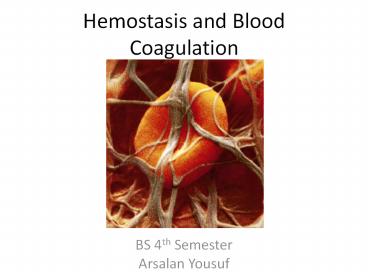Hemostasis and Blood Coagulation - PowerPoint PPT Presentation
Title:
Hemostasis and Blood Coagulation
Description:
Hemostasis and Blood Coagulation BS 4th Semester Arsalan Yousuf Hemostasis Prevention of blood loss. Achieved through following mechanisms: Vascular constriction, (2 ... – PowerPoint PPT presentation
Number of Views:4071
Avg rating:3.0/5.0
Title: Hemostasis and Blood Coagulation
1
Hemostasis and Blood Coagulation
- BS 4th Semester
- Arsalan Yousuf
2
Hemostasis
- Prevention of blood loss. Achieved through
following mechanisms - Vascular constriction,
- (2) Formation of a platelet plug,
- (3) Formation of a blood clot as a result of
blood coagulation, - (4) Eventual growth of fibrous tissue into the
blood clot.
3
Vascular Constriction
- After a blood vessel has been cut or ruptured,
the trauma to the vessel wall causes the smooth
muscle in the wall to contract. - Local myogenic spasm,
- (2) Local autacoid factors from the traumatized
tissues and blood platelets, - (3) Nervous reflexes.
More vasoconstriction results from local myogenic
contraction of the blood vessels initiated by
direct damage to the vascular wall. The
platelets are responsible for much of the
vasoconstriction by releasing a vasoconstrictor
substance, Thromboxane A2
Formation of the Platelet Plug
If the cut in the blood vessel is very small the
cut is sealed by a platelet plug, rather than by
a blood clot.
4
Platelets
- Platelets (thrombocytes) are minute discs 1 to 4
µm in diameter. - Formed in the bone marrow from megakaryocytes,
- The normal concentration of platelets in the
blood is between 150,000 and 300,000 per µL.
- COMPONENTS
- Actin and myosin molecules.
- Residuals of both the Endoplasmic Reticulum and
Golgi apparatus. - Mitochondria and enzymes that are capable of
forming ATP. - Fibrin-stabilizing factor.
- A coat of glycoproteins that repulses adherence
to normal endothelium. - Half life of 8 to 12 days.
5
Platelet Plug
When platelets come in contact with a damaged
vascular surface, they immediately change their
own characteristics.
- Begin to swell
- Assume irregular forms with numerous irradiating
pseudopods - Release granules that contain multiple active
factors - Become sticky and adhere to collagen in the
tissues and to a protein called von Willebrand
factor that leaks into the traumatized tissue
from the plasma - Secrete large quantities of ADP
- Enzymes form thromboxane A2.
- ADP and thromboxane in turn act on nearby
platelets to activate them as well.
6
(No Transcript)
7
Blood Coagulation in the Ruptured Vessel
Blood clot begins to develop in 15 to 20 seconds
if the trauma to the vascular wall is severe,
In 1 to 2 minutes if the trauma is minor.
- Once a blood clot has formed, it can follow one
of two courses - It can become invaded by fibroblasts,
- It can dissolve
8
(No Transcript)
9
Mechanism of Blood Coagulation The Basic Theory
Whether blood will coagulate depends on the
balance between Coagulants and Anticoagulants.
10
Thrombin and Fibrinogen
- Prothrombin is a plasma protein, an
alpha2-globulin, having a molecular weight of
68,700. It is present in normal plasma in a
concentration of about 15 mg/dl. - Unstable protein
- Produced continuously in the liver. Vitamin K is
important for its formation.
- Thrombin in turn acts as a serine protease that
converts soluble fibrinogen into insoluble
strands of fibrin, as well as catalyzing many
other coagulation-related reactions.
11
Vicious Circle of Clot Formation
A clot itself initiates a vicious circle
(positive feedback) to promote more
clotting. Thrombin has a direct proteolytic
effect on prothrombin itself, tending to convert
this into still more thrombin.
Initiation of Coagulation Formation of
Prothrombin Activator
Extrinsic Pathway
Intrinsic Pathway
12
Extrinsic Pathway for Blood Clotting
Begins with trauma to the vascular wall and
surrounding tissues
13
Intrinsic Pathway for Blood Clotting
Begins in the blood itself.
Factor VIII is the factor that is missing in a
person who has classic hemophilia, for which
reason it is called antihemophilic
factor. Platelets are the clotting factor that
is lacking in the bleeding disease called
thrombocytopenia.
14
Importance of Calcium ions
- Except for the first two steps in the intrinsic
pathway, calcium ions are required for promotion
or acceleration of all the blood-clotting
reactions. - When blood is removed from a person, it can be
prevented from clotting by reducing the calcium
ion concentration. - The extrinsic pathway can be explosive. The
intrinsic pathway is much slower to proceed,
usually requiring 1 to 6 minutes to cause
clotting.































